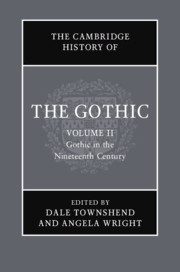Book contents
- The Cambridge History of the Gothic
- The Cambridge History of the Gothic
- The Cambridge History of the Gothic
- Copyright page
- Contents
- Illustrations and Captions for Volume II
- Tables
- Notes on Contributors
- Acknowledgements
- Introduction: Gothic in the Nineteenth Century, 1800–1900
- 2.1 Gothic Romanticism and the Summer of 1816
- 2.2 Fantasmagoriana: The Cosmopolitan Gothic and Frankenstein
- 2.3 The Mutation of the Vampire in Nineteenth-Century Gothic
- 2.4 From Romantic Gothic to Victorian Medievalism: 1817 and 1877
- 2.5 Nineteenth-Century Gothic Architectural Aesthetics: A. W. N. Pugin, John Ruskin and William Morris
- 2.6 Gothic Fiction, from Shilling Shockers to Penny Bloods
- 2.7 The Theatrical Gothic in the Nineteenth Century
- 2.8 ‘Spectrology’: Gothic Showmanship in Nineteenth-Century Popular Shows and Media
- 2.9 The Gothic in Victorian Poetry
- 2.10 The Genesis of the Victorian Ghost Story
- 2.11 Charles Dickens and the Gothic
- 2.12 Victorian Domestic Gothic Fiction
- 2.13 The Gothic in Nineteenth-Century Spain
- 2.14 The Gothic in Nineteenth-Century Italy
- 2.15 The Gothic in Nineteenth-Century Scotland
- 2.16 The Gothic in Nineteenth-Century Ireland
- 2.17 The Gothic in Nineteenth-Century America
- 2.18 Nineteenth-Century British and American Gothic and the History of Slavery
- 2.19 Genealogies of Monstrosity: Darwin, the Biology of Crime and Nineteenth-Century British Gothic Literature
- 2.20 Gothic and the Coming of the Railways
- 2.21 Gothic Imperialism at the Fin de siècle
- Select Bibliography
- Index
Introduction: Gothic in the Nineteenth Century, 1800–1900
Published online by Cambridge University Press: 18 July 2020
- The Cambridge History of the Gothic
- The Cambridge History of the Gothic
- The Cambridge History of the Gothic
- Copyright page
- Contents
- Illustrations and Captions for Volume II
- Tables
- Notes on Contributors
- Acknowledgements
- Introduction: Gothic in the Nineteenth Century, 1800–1900
- 2.1 Gothic Romanticism and the Summer of 1816
- 2.2 Fantasmagoriana: The Cosmopolitan Gothic and Frankenstein
- 2.3 The Mutation of the Vampire in Nineteenth-Century Gothic
- 2.4 From Romantic Gothic to Victorian Medievalism: 1817 and 1877
- 2.5 Nineteenth-Century Gothic Architectural Aesthetics: A. W. N. Pugin, John Ruskin and William Morris
- 2.6 Gothic Fiction, from Shilling Shockers to Penny Bloods
- 2.7 The Theatrical Gothic in the Nineteenth Century
- 2.8 ‘Spectrology’: Gothic Showmanship in Nineteenth-Century Popular Shows and Media
- 2.9 The Gothic in Victorian Poetry
- 2.10 The Genesis of the Victorian Ghost Story
- 2.11 Charles Dickens and the Gothic
- 2.12 Victorian Domestic Gothic Fiction
- 2.13 The Gothic in Nineteenth-Century Spain
- 2.14 The Gothic in Nineteenth-Century Italy
- 2.15 The Gothic in Nineteenth-Century Scotland
- 2.16 The Gothic in Nineteenth-Century Ireland
- 2.17 The Gothic in Nineteenth-Century America
- 2.18 Nineteenth-Century British and American Gothic and the History of Slavery
- 2.19 Genealogies of Monstrosity: Darwin, the Biology of Crime and Nineteenth-Century British Gothic Literature
- 2.20 Gothic and the Coming of the Railways
- 2.21 Gothic Imperialism at the Fin de siècle
- Select Bibliography
- Index
Summary
This introductory chapter charts the major directions that the Gothic aesthetic took in Britain, America and Europe over the course of the nineteenth century. Commencing with an account of the critical formation and consolidation of the notion of ‘Gothic literature’ itself, it discusses the critical work of figures such as Nathan Drake, Walter Scott, George Stillman Hillard and Edmund Gosse. Showing the extent to which this literary-historical category was defined against, and in relation to, canonical British Romanticism, it surveys the anti-Gothic rhetoric of Samuel Taylor Coleridge, William Wordsworth, William Hazlitt and others. Through consideration of the work of Thomas B. Shaw, William John Courthope and Edward Dowden, it tracks the persistence of such Romantic attitudes in the literary historiography of the nineteenth century. Exploring, in its final sections, the volume’s contents, the Introduction situates the chapters that follow in relation to some of the major developments in literary, historiographical and architectural Gothic culture across the nineteenth century.
- Type
- Chapter
- Information
- The Cambridge History of the Gothic , pp. 1 - 18Publisher: Cambridge University PressPrint publication year: 2020
- 1
- Cited by

